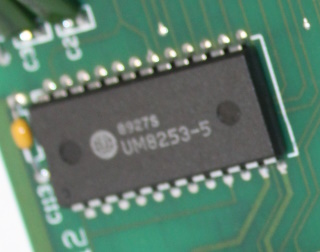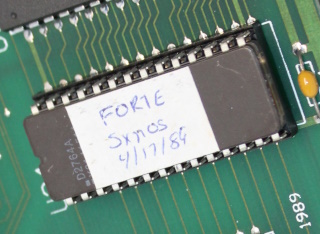Quick Look: Forte Audio F/X
19th December 2023
Regular DOS Days contributor Andrew Welburn (Andys Arcade) recently acquired this rather interesting early PC audio card - the Forte Audio F/X:
Forte Audio F/X (mid-1989, $249)
There is little information out there on this sound card, but Andrew's came with the original manuals and disks! He and I then did our own 'digital archeology' to piece together this information on it.
An article in Education Computer News, Volume 7 1990 reads:
The Audio F/X spec sheet lists:
- Two MOS 6582 SID (Sound Interface Device) chips - 3 channels each, 6 in total
- Onboard Z80 microprocessor for offloading much of the work from the PC's CPU
- 8-bit ISA bus connection
- Bundled software: SONATA music editor, SynCom toolkit, Sound Editor, installation disk and utilities
- Optional microphone, filter box and speakers
The most obvious thing you'll notice about this sound card is that it's not designed for the mainstream PC gamer; it's really for audio recording/playback and for the creation of sound effects. As such, there is no compatibility with any popular PC sound standards that were around in 1989 such as Ad Lib and Sound Blaster. What makes this really unique is its use of the SID chip (two of them!) - the same found in the Commodore 64 and 128 home computers.
The Flypast
The Forte Audio F/X is what appears to be a full-length 8-bit ISA (AT bus) card, so the leftmost edge of the card would also slot into a plastic groove within the case for extra stability.
 SID Chips
SID Chips
Starting with probably the most interesting components of the board, we have the two MOS 6582 chips. There is a ton of information on the web about the infamous SID which played a huge role in propelling the Commodore 64 to popularity in the early 1980s.
Each SID chip can produce 3 voices (channels), each with its own oscillator. Four types of waveforms are able to be selected per voice: pulse wave, triangle wave, sawtooth wave, and white noise. Because each voice can play a different waveform at the same time as other voices, complex sounds can be created.
Actually the C64 used the slightly earlier MOS Technology 6581 (and later, the 8580) - these are the 6582 variant, which is the same as the 6581 but manufactured using the HMOS II process.
Z80 Microprocessor
 The Z80 CPU is there to process commands being sent to the Audio F/X independently of the host PC's CPU, allowing it to focus on other instructions. This wasn't common practice for audio cards - manufacturers needed to keep the costs down and adding a microprocessor would have been an expensive thing to put into the design. As such, you would typically only find a dedicated CPU on an add-on card if it were a premium model.
The Z80 CPU is there to process commands being sent to the Audio F/X independently of the host PC's CPU, allowing it to focus on other instructions. This wasn't common practice for audio cards - manufacturers needed to keep the costs down and adding a microprocessor would have been an expensive thing to put into the design. As such, you would typically only find a dedicated CPU on an add-on card if it were a premium model.
Having said that, the Zilog Z80 was a very cost-effective choice in 1989 - easy to program and known to be reliable and well-supported. This one is a licenced one fabricated by SGS Thomson, model Z8400BB1, and runs at 6 MHz.
Timer
 The Audio F/X has an onboard programmable timer in the UMC UM8253 that sits right next to the SID chips. This timer chip has 3 independent 16-bit counters able to operate at up to 2.6 MHz.
The Audio F/X has an onboard programmable timer in the UMC UM8253 that sits right next to the SID chips. This timer chip has 3 independent 16-bit counters able to operate at up to 2.6 MHz.
Each of the SID chip's 8-bit channels can be run at their own frequency, so this timer is used to control the timing of each of the channels.
RAM
 The card also has 8 KB of onboard static RAM, which is the UMC UM6264 chip below the leftmost SID chip.
The card also has 8 KB of onboard static RAM, which is the UMC UM6264 chip below the leftmost SID chip.
This is used as a temporary data buffer when processing / recording audio. The operation manual suggests there is no limit to the size of a recording you can make using the Audio F/X, apart from free hard disk space.
EPROM
 Next to the SRAM IC is the Forte EPROM which holds the firmware for the card. This is an Intel D2764 UV-erasable EPROM with 64 KB capacity. The sticker on the top reads 'Forte Synos 4/17/89'.
Next to the SRAM IC is the Forte EPROM which holds the firmware for the card. This is an Intel D2764 UV-erasable EPROM with 64 KB capacity. The sticker on the top reads 'Forte Synos 4/17/89'.
Andrew dumped the code from this EPROM chip, which can be downloaded further down this article.
There are also three PAL (Programmable Array Logic) chips, which are used to reduce the number of discrete components required to handle logic on the board. Andrew has dumped the contents of these too, reading them as 27C020 ICs (see below for download).
Board Configuration
Like almost every other sound card, the Audio F/X communicates with the PC via an interrupt request and can access memory via a DMA channel to avoid going through the CPU. These are configured using the 8-jumper block at JP1 on the card.
Configuration Options (default setting in bold):
Base Address: 300h, 308h, 310h, or 318h
IRQ: 1 or 3
DMA Channel: 3 or 5
Bundled Software
Forte developed their own software for this card, comprising the following:
Sonata Music Editor v2.0 - two 5.25" floppy disks
Sound Editor Graphic Wave Form Processor v.4 - one 5.25" floppy disk
Syncom Sound Tool v1.0 - one 5.25" floppy disk
Syncom Synthesizer Compiler - one 5.25" floppy disk

Bundled floppy disks with the Forte Audio F/X card
Recording audio using the Audio F/X requires you to connect the patch cord supplied in the box, which has a mini-stereo jack on one end, and an RCA connector on the other. The 3.5mm jack connects to the bottom-most connector on the card's backplate, and the RCA connects to your audio source.
Andrew hopes to get this card operational and take some recordings from it - I look forward to seeing what it can do!
Downloads
This section contains the downloads provided by Andrew, including the manuals and ROM dumps.
Audio F/X Installation Manual The card's installation manual in PDF format. |
Addendums Other related single-page docs in PDF format. |
Sonata User Manual The music editor software user manual in PDF format. |
Sound Editor User Manual The sound editor (wave form processor) software user manual in PDF format. |
SynCom Interactive Sound Tool The Synthesizer Compiler user manual in PDF format. |
Programmer's Toolkit Manual The Programmer's Toolkit manual in PDF format. |
U22 ROM Dump A dump of the code from the IC at location U22. |
U23 ROM Dump A dump of the code from the IC at location U23. |
U24 ROM Dump A dump of the code from the IC at location U24. |
U25 ROM Dump A dump of the code from the IC at location U25. |
Install Disk A 360 KB disk image of the INSTALL disk. |
Sonata Disk #1 A 360 KB disk image of the Sonata Disk 1 disk. |
Sonata Disk #2 A 360 KB disk image of the Sonata Disk 2 disk. |
Sound Editor Disk A 360 KB disk image of the Sound Editor disk. |
SynCom Disk #1 A 360 KB disk image of the SynCom Disk 1 disk. |
If you have any more information on the Forte Audio F/X card and wish to share it with me or Andrew, please get in touch using the 'Contact Us' link below.
.png)